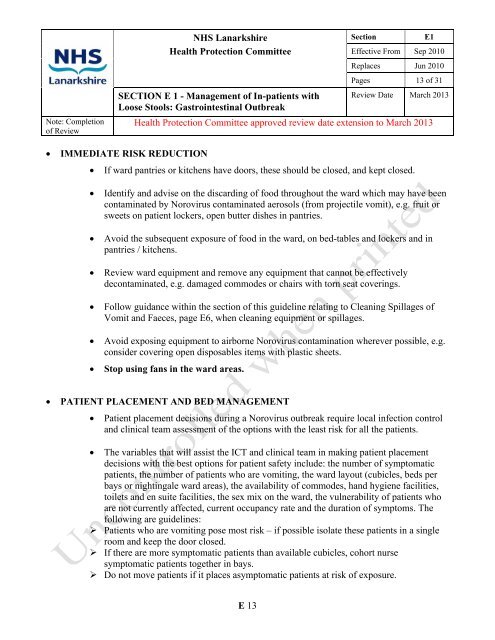Management of In-patients with Loose Stools ... - NHS Lanarkshire
Management of In-patients with Loose Stools ... - NHS Lanarkshire
Management of In-patients with Loose Stools ... - NHS Lanarkshire
Create successful ePaper yourself
Turn your PDF publications into a flip-book with our unique Google optimized e-Paper software.
Note: Completion<br />
<strong>of</strong> Review<br />
<strong>NHS</strong> <strong>Lanarkshire</strong><br />
Health Protection Committee<br />
Section E1<br />
Effective From Sep 2010<br />
Replaces Jun 2010<br />
Pages 13 <strong>of</strong> 31<br />
SECTION E 1 - <strong>Management</strong> <strong>of</strong> <strong>In</strong>-<strong>patients</strong> <strong>with</strong><br />
<strong>Loose</strong> <strong>Stools</strong>: Gastrointestinal Outbreak<br />
Review Date March 2013<br />
Health Protection Committee approved review date extension to March 2013<br />
IMMEDIATE RISK REDUCTION<br />
If ward pantries or kitchens have doors, these should be closed, and kept closed.<br />
Identify and advise on the discarding <strong>of</strong> food throughout the ward which may have been<br />
contaminated by Norovirus contaminated aerosols (from projectile vomit), e.g. fruit or<br />
sweets on patient lockers, open butter dishes in pantries.<br />
Avoid the subsequent exposure <strong>of</strong> food in the ward, on bed-tables and lockers and in<br />
pantries / kitchens.<br />
Review ward equipment and remove any equipment that cannot be effectively<br />
decontaminated, e.g. damaged commodes or chairs <strong>with</strong> torn seat coverings.<br />
Follow guidance <strong>with</strong>in the section <strong>of</strong> this guideline relating to Cleaning Spillages <strong>of</strong><br />
Vomit and Faeces, page E6, when cleaning equipment or spillages.<br />
Avoid exposing equipment to airborne Norovirus contamination wherever possible, e.g.<br />
consider covering open disposables items <strong>with</strong> plastic sheets.<br />
Stop using fans in the ward areas.<br />
PATIENT PLACEMENT AND BED MANAGEMENT<br />
Patient placement decisions during a Norovirus outbreak require local infection control<br />
and clinical team assessment <strong>of</strong> the options <strong>with</strong> the least risk for all the <strong>patients</strong>.<br />
The variables that will assist the ICT and clinical team in making patient placement<br />
decisions <strong>with</strong> the best options for patient safety include: the number <strong>of</strong> symptomatic<br />
<strong>patients</strong>, the number <strong>of</strong> <strong>patients</strong> who are vomiting, the ward layout (cubicles, beds per<br />
bays or nightingale ward areas), the availability <strong>of</strong> commodes, hand hygiene facilities,<br />
toilets and en suite facilities, the sex mix on the ward, the vulnerability <strong>of</strong> <strong>patients</strong> who<br />
are not currently affected, current occupancy rate and the duration <strong>of</strong> symptoms. The<br />
following are guidelines:<br />
Patients who are vomiting pose most risk – if possible isolate these <strong>patients</strong> in a single<br />
room and keep the door closed.<br />
If there are more symptomatic <strong>patients</strong> than available cubicles, cohort nurse<br />
symptomatic <strong>patients</strong> together in bays.<br />
Do not move <strong>patients</strong> if it places asymptomatic <strong>patients</strong> at risk <strong>of</strong> exposure.<br />
E 13

















